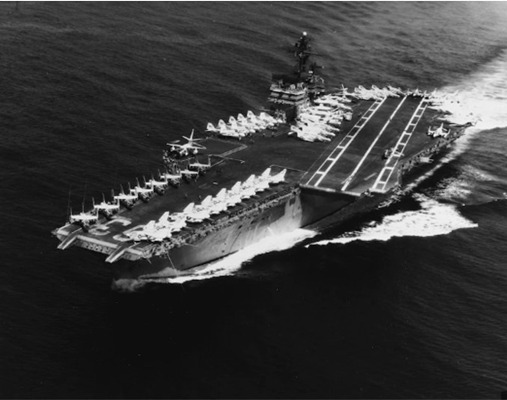Rioting aboard the USS Kitty Hawk
October 12, 1972

The aircraft carrier USS Kitty Hawk is sailing from the Philippines to Vietnam for extended combat duty. On the way, the questioning of an African American Sailor about an incident that occurred ashore at Subic Bay leads to a confrontation between African American Sailors and some of the ship’s officers. During ensuing confusion, small groups of white and African American Sailors roam the ship attacking Sailors of the opposite race. As a result, 47 Sailors are injured and 21 are charged with offenses.
Throughout the war, the U.S. military experiences rising racial tension across the services. It leads to significant and sometimes violent incidents, predominantly outside the theater of operations and in rear areas in Southeast Asia. A notably small number of such incidents are reported in combat areas. Military and civilian concern over these episodes fuels long term efforts at reform, and will precipitate formal actions for increasing equal opportunity in the military.1
Unrest over racial prejudice affected all branches of the United States armed forces during the Vietnam War. Although the civil rights movement delivered significant gains for African Americans, racial tensions increased in the late 1960s as many African Americans’ demands for equality and integration remained unfulfilled. The 1964 Civil Rights Act outlawed the worst of the Jim Crow-era laws on segregation and voting, but African Americans everywhere still struggled for equal access to employment, housing, and education. In the Army, the draft inducted disproportionately-higher numbers of African Americans than white Americans, and higher numbers of African Americans were assigned to combat duties and other less desirable tasks due to lower scores on aptitude tests and performance reviews. As the United States’ involvement in Vietnam continued into the late 1960s, incidents of racial protest and violence increased dramatically in rear areas in Vietnam and on military bases around the globe. The United States Navy, however, appeared largely immune to observable racial incidents until the early 1970s, when the military’s withdrawal from Vietnam was nearly complete. Military historians identify several reasons for why racial unrest in the Navy, characterized most famously by the rioting aboard the USS Kitty Hawk in October 1972, appeared much later than in the Army and Marine Corps.
Historians argue that fears of being drafted to fight on the ground in Vietnam led many white Americans to enlist in the Navy in the 1960s. Thus, the Navy possessed a much lower percentage of African Americans than other branches, and most African Americans in the Navy were concentrated in menial positions. In the early 1970s, President Nixon began to wind down the draft, a policy that led to a decrease of high-quality recruits choosing the Navy and a subsequent increase of working-class and minority enlistees. Weaker scores on aptitude tests coupled with a decline in the overall size of the fleet meant many of these new sailors had little opportunity for advancement. At the same time that the United States’ ground forces were pulling out of Vietnam, the Navy took on a proportionately greater role in the war by providing increased numbers of airstrikes and other support for Nixon’s Vietnamization policies. Further, sailors on the USS Kitty Hawk in 1972 had endured an unusually long deployment, and the duties associated with having to prepare aircraft to fly more sorties per day than any other aircraft carrier made for a tired and potentially irritable crew. Shipboard practices, such as enabling sailors to self-segregate berthing quarters, also contributed to an environment increasingly rife with tension.
The USS Kitty Hawk suffered from a series of racially motivated incidents throughout the summer and fall of 1972. The vessel’s commander realized trouble was brewing, and he held open forums to address any issues and created a permanent board of officers to hear and rectify complaints. Despite these well-intended efforts, fights between white and black crew members during a stay in Subic Bay, Philippines, followed by the announcement that the crew’s deployment would be extended brought tensions to the boiling point. On October 12, a group of African American sailors, unhappy with what they perceived to be unjust punishments, occupied a mess hall area and taunted officers when ordered to leave. The ship’s Executive Officer, an African American aviator named Benjamin Cloud, diffused tensions by reasoning with the outraged sailors. Meanwhile, numerous racially-motivated assaults occurred throughout the ship before the situation calmed down the following morning. The incident on the Kitty Hawk proved to be one of the most widely-reported of many cases of racial unrest in the Navy during the early 1970s. Not until mid-decade, when affirmative action-type reforms implemented by Chief of Naval Operations Elmo “Bud” Zumwalt began to change institutional culture and the frustrations among Vietnam War servicemen began to lessen, did racial tension diminish within the fleet.
Westheider, James E. The African American Experience in Vietnam: Brothers in Arms. Lanham, MD: Rowman and Littlefield Publishers, 2008.
Sherwood, John Darrell. Black Sailor, White Navy: Racial Unrest in the Fleet During the Vietnam War. New York: New York University Press, 2007.